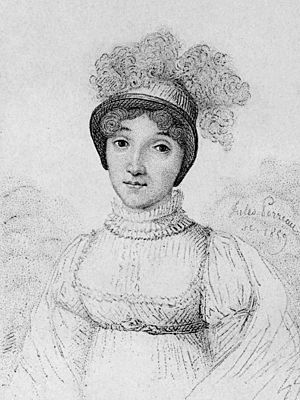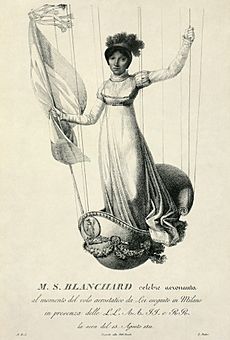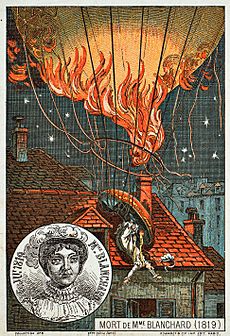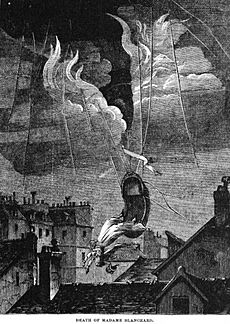Sophie Blanchard facts for kids
Quick facts for kids
Sophie Blanchard
|
|
|---|---|

Blanchard shown in an 1859 engraving by Jules Porreau
|
|
| Born | 25 March 1778 Trois-Canons, Kingdom of France (now Yves, France)
|
| Died | 6 July 1819 (aged 41) Paris, France
|
| Cause of death | Balloon crash |
| Nationality | French |
| Known for | First woman to work as a professional balloonist |
| Spouse(s) | Jean-Pierre Blanchard |
| Aviation career | |
| First flight | 1804 |
Sophie Blanchard (born March 25, 1778 – died July 6, 1819) was a French aeronaut. She was married to Jean-Pierre Blanchard, who was a pioneer in ballooning. Sophie was the first woman to become a professional balloonist. After her husband passed away, she continued flying balloons, completing over 60 flights.
Sophie Blanchard was famous across Europe for her balloon adventures. She even performed for important leaders like Napoleon Bonaparte and Louis XVIII of France. Napoleon gave her the title "Aeronaut of the Official Festivals." Later, Louis XVIII named her "Official Aeronaut of the Restoration."
Ballooning was very dangerous back then. Sophie sometimes fainted, faced freezing cold, and almost drowned when her balloon landed in a marsh. Sadly, in 1819, she became the first woman to die in an aviation accident. During a show in Paris, fireworks she launched set her balloon on fire. Her balloon crashed onto a house roof, and she fell to her death.
Contents
Sophie's Amazing Life
Early Flights and Career
Sophie Blanchard was born Marie Madeleine-Sophie Armant. She grew up near La Rochelle, France. We don't know much about her life before she married Jean-Pierre Blanchard. He was the world's first professional balloonist. Most sources say they married in 1804, which was the year of her first balloon flight.
Sophie was described as small and a bit nervous on the ground. She was scared of loud noises and riding in carriages. But in the air, she was completely fearless! In 1807, she and her husband had an accident during a flight. They crashed, and her husband was hurt.
Sophie's first balloon flight with her husband was on December 27, 1804, in Marseilles. The couple was having money problems. They hoped that having a woman balloonist would attract more attention and help them financially. Sophie said flying felt like an "incomparable sensation." She flew with her husband again. Then, on August 18, 1805, she made her first solo flight from Toulouse.
Sophie was not the very first woman to fly in a balloon. Other women had flown before her, like Élisabeth Thible in 1784. But Sophie was the first woman to pilot her own balloon. She was also the first woman to make ballooning her full-time job.
In 1809, her husband died after falling from his balloon. After this, Sophie kept flying. She became known for her night flights, often staying in the air all night long.
Flying Solo
Sophie experimented with parachutes, just like her husband had. She would drop dogs from her balloon using parachutes. For her shows, she would launch fireworks and drop baskets of fireworks attached to small parachutes. Other balloonists, like the Garnerin family, were famous for parachute jumps. Élisa Garnerin was Sophie's main rival.
Sophie was still in debt after her husband's death. To save money, she chose a special type of balloon. She used a hydrogen-filled gas balloon. This kind of balloon was smaller and easier to inflate. It also meant she didn't need a fire to keep it in the air, unlike a hot air balloon. Since Sophie was small and light, she didn't need as much gas to make her balloon fly.
Sophie became a favorite of Napoleon. In 1804, he put her in charge of organizing balloon displays for big events. She was called "Aeronaut of the Official Festivals." She even helped plan for an air invasion of England, but she convinced Napoleon it wouldn't work because of the winds.
She performed for Napoleon on June 24, 1810, in Paris. She also flew for his wedding and for the birth of his son. During her flight for his son's birth, she dropped leaflets over Paris announcing the news. She also performed at his son's baptism and at a festival in Milan. In 1811, she flew in bad weather in Naples for Napoleon's brother-in-law.
When Louis XVIII returned to the French throne in 1814, Sophie flew her balloon over Paris as part of the celebration. Louis was so impressed that he named her "Official Aeronaut of the Restoration."
Sophie was famous all over Europe. People flocked to see her flights. In Frankfurt, her show was so popular that it caused an opera to have a small audience! She gave many shows in Italy. In 1811, she flew from Rome to Naples. She also flew from Rome to a height of 12,000 feet, where she said she fell asleep for a while. That same year, she fainted again after flying high to avoid a hailstorm. She stayed in the air for 14 and a half hours!
Sophie even crossed the Alps by balloon. On a trip to Turin in 1812, it got so cold that her nose bled, and icicles formed on her hands and face. She almost died in 1817 during a flight from Nantes. She landed in a marsh, and her balloon got caught in a tree. Her chair tipped over, and she fell into the water. Luckily, help arrived quickly.
Her Last Flight
On July 6, 1819, Sophie Blanchard was performing at the Tivoli Gardens in Paris. Her hydrogen-filled balloon caught fire. Sophie, tangled in the net around the balloon, fell to her death.
Sophie often performed at the Tivoli Gardens. She had been warned many times about the danger of using fireworks during her shows. This particular show was planned to have even more fireworks than usual. Some people in the crowd begged her not to fly, but others wanted to see the show. One report says she stepped into her balloon chair saying, "Let's go, this will be for the last time."
Around 10:30 p.m., Sophie began her flight. She was wearing a white dress and a white hat with ostrich feathers. The wind was strong, and the balloon struggled to go up. She threw out some weight to gain height. Once she was above the trees, she started her show by waving her flag. The balloon was lit up by baskets holding "Bengal fire" (a type of slow-burning, colored firework).
Moments after she started the display, the balloon caught fire. The gas inside the balloon was burning. Sophie's balloon began to fall quickly. Some people in the crowd thought this was part of the show and cheered. The balloon had not gone very high. Even though the gas was burning, there was enough lift to keep it from falling straight down. Sophie quickly threw out more weight to slow her fall. Most reports say she seemed calm as she fell.
The balloon ran out of gas just above the roofs of a street called Rue de Provence. It hit the roof of a house. It's thought she might have survived if that was all that happened. But the ropes holding her chair to the balloon may have burned through, or the impact might have thrown her. Sophie, still tangled in the balloon's net, fell off the roof into the street below.
Crowds rushed to help her, but she died almost instantly from a broken neck.
The most likely cause of the accident was that the fireworks attached to her balloon were knocked out of place by a tree as she went up. When she lit the fuses, the fireworks shot towards the balloon instead of away from it. One of them burned a hole in the fabric, setting the gas on fire.
Remembering Sophie
After Sophie died, the owners of the Tivoli Gardens announced that money from ticket sales would go to support her children. People in Paris also collected donations. They raised 2,400 francs. But then they found out Sophie had no children who were still alive. So, the money was used to build a memorial above her grave in Père Lachaise Cemetery. Her tombstone says she was "victim of her art and intrepidity." The rest of the money, about 1,000 francs, was given to the church Sophie attended. Even though she wasn't rich, she had paid off her husband's debts and was financially stable when she died.
Sophie's death story was told all over Europe. Jules Verne mentioned her in his book Five Weeks in a Balloon. Fyodor Dostoevsky also wrote about her in The Gambler. Her story showed how famous she was.
A novel inspired by her life, The Little Balloonist, was published in 2006. In 2019, a movie called The Aeronauts featured a character partly inspired by Sophie Blanchard.
See also
 In Spanish: Sophie Blanchard para niños
In Spanish: Sophie Blanchard para niños






